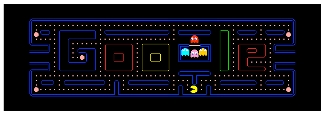Over the past weekend, Pacman had its 30th anniversary. To celebrate this, Google changed its logo into a working Pacman game. I can only speak for myself, but a few spins around the maze were enough to put me right back into my sweaty, pre-teen arcade years when Pacman frustrated the hell out of me. I can remember the growing paranoia and fear while I tried to outrun the ghosts. Other people played the game so effortlessly while I struggled. It was almost too much for my young self to handle.
But the Google page got me thinking. I knew that sitting in my house, in an old portable cooler box, was my Atari 2600 console and a few dozen games, one of which is Pacman. If you aren’t familiar with the Atari 2600 Pacman, it wasn’t anything like the arcade game. I know I wasn’t the only disappointed kid to fire up their game and wonder “wha…?” The main concept was there: eat pellets before the ghosts get you (for you young kids out there, video games used to lack a story, you just racked up points), but nothing else was the same. Not the sounds, not the graphics, not even the way the game played.
With the 30th anniversary in mind and my heart still thumping from a few games of online Pacman, I bought a inexpensive plug adapter and connected the Atari to my television. I didn’t know if it would still work, but it would be worth the effort. To my relief, the machine worked. Now it was time to relive the joys of Atari’s Pacman. Several decades have passed since the last time I played this game, but I figured I would be up to the task.
I’m not sure if it was the age of the machine or just the way the game worked, but moving Pacman around felt like sliding in muddy snow. Getting the little dude to change direction was so difficult you often went past openings you wanted to turn into, and then you would just slide along the path until you hit a wall. I kept running into ghosts when I was trying to turn. I kept eating power pellets (whatever they’re called, the glowing pellet that makes it so you can eat the ghosts) when I meant to leave them in place. My children thought the whole thing was hilarious and they kept asking me to run into the ghosts so I would die. I eventually got it down so I could make corners, but I couldn’t help imagining a car skidding in winter.
The sounds, well, if you don’t know them, they’re almost impossible to describe. The game starts with an awful wailing siren, and then when Pacman eats a pellet, it sounds like a cross between an old-time door buzzer and a spring getting flicked. The familiar dying noise when a ghost got you was replaced with a rising cacophony of trilling bells. I know it seems like a minor thing, but the Google version of Pacman has the actual arcade sounds; they have a soothing nostalgic feel to them. The Atari 2600 sounds are so bad they almost make the game unplayable. Almost.
It’s hard to look at the 2600 objectively. I don’t really play any modern games, but I see commercials on TV and several old college buddies work as game designers, so I’m not completely clueless as to what’s out on the market. I know when the Atari came out it was cutting edge. I spent hours and hours every night and weekend playing on the thing. Kids from the neighborhood would come over to play. There would be fights over whose turn was next. But looking at it today, its graphics are so inferior to modern games there’s no comparing the two. The game play is poor, and I don’t think it’s just the age of my machine. And in this particular example, the arcade game was superior.
And yet, there’s a certain fondness I have for the Atari. I can’t believe it’s been 30 years already since Pacman and console games first entered our lives. Now I want to spend all my time again playing things like Space Invaders, Missile Command, Pitfall!, Combat, and Kaboom! I think I will. How about you?
John Klima edits the Hugo Award winning Electric Velocipede.










